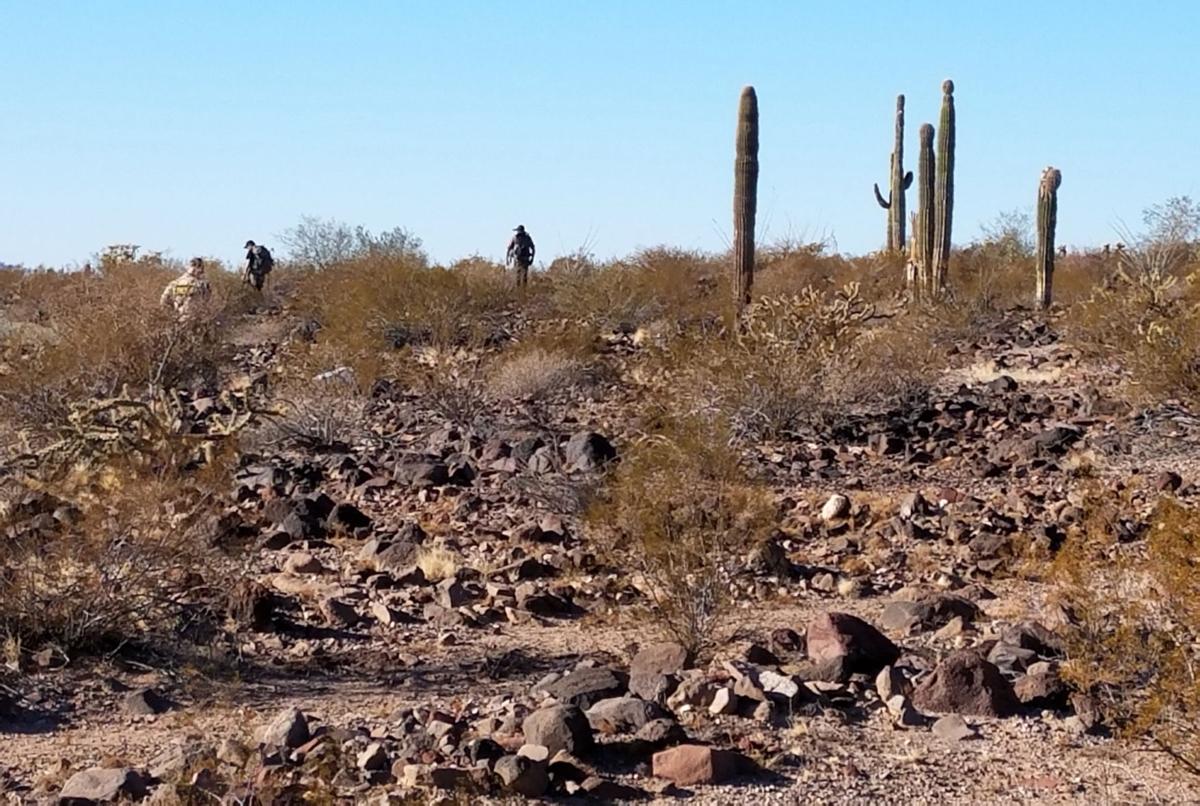A new effort by migrant-aid workers to search desert areas west of Tucson for illegal border crossers who died led to the discovery last week of four sets of skeletal remains near Ajo.
The discovery of human remains near Hat Mountain on Dec. 18 and in the Growler Valley in the following four days brings the total number of remains found in the desert since Jan. 1 to 155, according to the Pima County Office of the Medical Examiner.
The remains of more than 2,700 people, many of them undocumented border crossers, have been found in Southern Arizona since 2001, medical examiner records show.
All of the recently discovered remains were found in desert areas and consisted of pieces of bone, such as skulls or jaws, that were “obviously very, very old,” said Deputy Ryan Inglett, a spokesman with the Pima County Sheriff’s Department.
The remains were discovered during the first week of a new volunteer program, made up of aid workers from the Ajo Samaritans and the No More Deaths chapters in Tucson and Phoenix, that focuses on areas near Ajo that have not been thoroughly explored, Genevieve Schroeder, a spokeswoman for No More Deaths, said via email.
The Ajo area is “arguably the most remote and deadly area along the entire border,” she said, noting the extreme heat, lack of water and shade, and long distances without roads or towns.
The fact that illegal immigrants cross the border through the Ajo corridor “illustrates that border enforcement policy continues to drive migration into increasingly perilous terrain,” she said.
“Coming across human remains in these areas is sad and infuriating,” Schroeder said. “These are deaths caused by global inequalities and an inherently inhumane border policy — prevention through deterrence.”
As a result of that policy, which began in the 1990s and was designed to funnel migrants away from urban areas and into the wilderness, “the threat of death, and further, of disappearance, is leveraged against migrating people,” she said.
The Border Patrol did not respond to questions about the claims made by No More Deaths, but the agency issued a statement saying Tucson Sector agents partner with foreign and local authorities through the Missing Migrant Program to “gather pertinent information which may lead to a rescue, recovery, or identification of deceased migrants.”
Although apprehensions in Southern Arizona have fallen precipitously since peaking in 2000, authorities and aid workers continue to find bodies in the desert, and families still look for lost loved ones.
Fingerprint identification records provided by the Border Patrol show 339,000 individuals were arrested in fiscal year 2000. In fiscal year 2015, agents arrested 54,000 individuals.
But the 133 human remains reported by the Pima County medical examiner in fiscal year 2015 and the 146 in fiscal year 2016 follow the trend of between 100 and 250 sets of remains found annually in recent years.
As was the case with the remains found last week, many of the remains are skeletal, which indicates they are not recent deaths.
While migrant deaths rightfully receive attention, Schroeder said, the numerous cases of migrants who have gone missing while crossing the border is an equally important crisis.
More than 800 people along the length of the U.S.-Mexico border called the Missing Migrant Crisis Line in 2015 to report a friend or family member had gone missing while crossing the border, according to a Dec. 7 report from No More Deaths and the Coalición de Derechos Humanos.
A looming question is how many undiscovered human remains are on the Barry M. Goldwater Air Force Range southwest of Ajo, where access for aid workers is restricted, Schroeder said.
The Dec. 7 report attributes many of the missing migrant cases to a Border Patrol practice of “chase and scatter,” in which agents come upon groups of people who run away into dangerous terrain. The report acknowledges that chase is the sole method of apprehension available to agents if border crossers do not surrender to them.
But it can have tragic consequences, such as the March 2015 death of Jose Cesario Aguilar Esparza, who died after falling from a cliff while running from agents during a border-crossing attempt.
In the report, the groups describe missing migrants as “disappeared,” the word used most often by callers when they describe their missing loved ones. It also is a term widely used in Latin America to refer to people kidnapped and killed without explanation by authoritarian regimes. The report cited a 2006 United Nations definition of “enforced disappearance,” in which a state policy causes disappearances but does not target specific individuals.
Along the U.S.-Mexico border, “the disappearance of hundreds of border crossers is not a natural or inevitable phenomenon, but rather a direct consequence of U.S. border-enforcement policies and practices,” the report said.
In response to the report, the Border Patrol issued a statement saying many migrant deaths result from smugglers who “knowingly victimize people wanting quick passage” across the border.
“Smugglers lie, telling their ‘customers’ their passage will be safe, but in reality, the terrain is treacherous and the conditions are extreme,” the agency said. “Many are led to their deaths by smugglers more concerned about making money than they are about the lives of others.”
The Border Patrol’s Tucson Sector has 36 rescue beacons, and all agents are trained to handle immediate medical needs while in the field, including 230 agents trained as emergency medical technicians and 54 Border Patrol Search, Trauma, and Rescue agents, the agency said.
U.S. Customs and Border Protection, the parent agency of the Border Patrol, “values human life” and collaborates with foreign and local authorities and organizations “to educate potential migrants about the true dangers of crossing the border illegally.”





